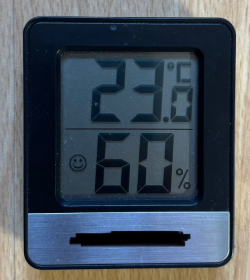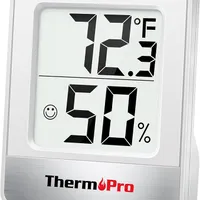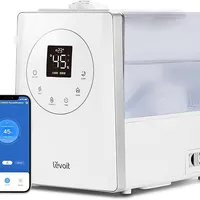The Ultimate Guide to Humidity for Houseplants
Hello plant parents! Ever wondered why some of your leafy friends look a bit crispy around the edges, while others are thriving? The secret might be in the air - literally!
Let's talk about humidity, that invisible yet crucial factor in your plants' happiness.
Unlike light or water, humidity often flies under the radar when it comes to plant care. But for many of our houseplants, especially the tropical ones, it's absolutely essential for their survival and growth.
Why should you care about humidity 💦?
- It helps plants absorb nutrients and water effectively
- It prevents leaf damage and browning edges
- It supports healthy growth and leaf development
- It mimics plants' natural habitat conditions
Let's dive into the misty world of plant humidity!
Understanding humidity
Simply put, humidity is the amount of water vapor present in the air. Think of it as invisible water floating around us!
For plants, humidity plays a crucial role in their daily functions. As they are constantly playing a balancing act with water. They need to:
- Take in CO2 through tiny pores (stomata) in their leaves
- Release oxygen and water vapor through these same pores
- Pull water and nutrients up from their roots
This process, called transpiration, allow of the plants to stay cool, move the nutrients in their system and maintain their overall cell structure.
It is also directly affected by humidity levels. When the air is too dry, plants lose water faster than they can replace it!
Why does it feels cold here?
A room full of plants actually feels cooler because of transpiration. Your plants are natural air conditioners!
How to measure humidity ?
To keep your plants happy, you'll want to monitor humidity levels. You can find various hygrometer models online. Digital versions are usually affordable online and reliable.


For the most accurate readings try to check the level at different time, season and in different rooms.
Ideal humidity levels
Most homes maintain humidity between 30-50%, which is comfortable for people but often too low for tropical plants which represents the vast majority of houseplants.
- For desert plants (Cacti, Succulents): 30-40%
- Common houseplants (Pothos, Spider Plants): 40-60%
- Tropical plants (Calathea, Ferns): 60% and more!
Plants can usually tolerate some variation from their ideal range, but try to keep it to the minimum and make sure those changes are gradual if they fluctuate.
Home heating and cooling systems
Your home's climate control might be great for you, but it's giving your plants a hard time!
While you enjoy that cozy warmth in winter, your heater is basically creating a mini desert in your home. Same goes for summer - your AC might keep you cool, but it's stealing precious moisture from the air.
Those radiators? They're basically hot spots that your plants aren't too fond of.
General rule of thumb: if you've got plants near any heating or cooling vents, you want to find them a new home, or at least give them some extra humidity.
Signs of humidity issues
Symptoms of low humidity
Watch out for these tell-tale signs:
- Crispy brown leaf tips or edges (aka the classic).
- Leaf curling or rolling inward.
- Yellowing leaves that drop.
- Flower buds falling before opening.
- New leaves are smaller or weirder than usual.
Symptoms of excessive humidity
Too much of a good thing can be problematic, watch out for the following signs:
- White fuzzy spots on soil or leaves (could be fungus or mold).
- Musty smell around plants.
- Yellow spots that turn brown (fungus!).
- Black spots on leaves.
- Rotting stems or leaves (usually comes with a bad smell).
Mold or fungus danger
If you spot any signs of mold or fungus, isolate the affected plant immediately to prevent spread to your other green friends!
How to increase humidity?
Let's explore ways to keep your plants comfortably moist!
The misting... myth!
Let's clear something up: misting isn't a good humidity solution.
It's like giving your plant a quick drink rather than a proper meal. Nice for cleaning leaves, but not great for sustained humidity.
The water you mist will evaporate in minutes, increasing humidity levels for nothing more than minutes, which is not what we are looking for here.
Some plants also hates water on their leaves!
Naturally humid areas
Ever notice how different rooms have different humidity levels? Your bathroom might feel like a mini rainforest after a shower, while the area near your heater could be as dry as a desert.
Naturally humid areas in your home are:
- Bathrooms: Perfect for moisture-loving plants (if it has a window or natural lighting).
- Kitchens: Cooking creates temporary humidity spikes (especially if you love pastas).
- Laundry rooms (from the dryer).
Pebble trays
A classic, easy and cheap method that actually works:
- Fill a tray with pebbles.
- Add water just below pebble surface.
- Place plant on top (pot shouldn't touch water).
- Refill as water evaporates.
Grouping plants
Plants together create their own humid microclimate. Since they naturally release moisture, you can have your plants in "packs" to locally increase humidity levels.
Humidifiers
When you need a serious humidity boost, it is the most effective solution. Think of it as a spa day for your plants, every day!
Check second-hand markets for humidifiers. You don't need a fancy "plant humidifier" - any clean, working humidifier will do the job!

This is the one I use in two rooms of my apartment. It's big and the auto-adjustable humidity level turns it off automatically. A tank lasts me about a week.
Hard water warning
If your water is hard, it can damage your humidifier and leave some spots on your furniture and plant leaves. Consider using a reverse osmosis system or filtered water before putting it in your humdifiying system!
How to decrease humidity?
If you're seeing mold or your windows are dripping, you might need to dial back the humidity.
Good air circulation is your friend here! Open a window, use a fan, or consider a dehumidifier if things are getting tropical.
Create a micro climate
Sometimes the best solution is to create a perfect little world for your plant!
The main challenge with these solutions is monitoring for rot and mold. With small to no air-flow, you have an higher chance to encounter these issues.
Humidity domes
Perfect for propagation and humidity-loving plants, you will contain the air around the plant to capture the humidity from the soil.
You can either use a clear plastic bag or a glass bell around the plant folliages. Any clear container can work!
Small warning tho: remember to remove the plant from it's dome gradually if needed to acclimate the plants to it's new humidity levels.
Terrarium
They usually require more work to set them up but they are perfect for moisture-loving plants by creating a natural humidity cycle.
They are also very nice to look at compared to the usual plastic bag!
Balancing humidity with overall plant care
Humidity and watering
The most obvious one, the higher the humidity the slower the water loss. This usually means less watering when humid, and more watering when dry air.
Be sure to check your soil moisture and adjust your watering schedule based on the humidity.
Humidity and pests
When you look at the pests and their relationship to humidity, it's a mix because you will find pests loving dry air, and other absolutely hating it.
For example, mealy bugs or fungus gnats will like high humidity that might go in pair with a moist soil.
In the contrary, spider mites prefer dry air for example.
If you have an issue with pest infestation, you might need to adjust your humidity level to fight it off! (Even if it might harm the plant for a bit. Suffering is better than dying...)
Summary
Phew! We've covered a lot about the misty world of plant humidity. Let's sum it up:
- Different plants need different humidity levels.
- Monitor and adjust humidity with the various technics based on your plants' signals.
- Balance humidity with other care factors.
The key to success is observation and consistency. Watch your plants, they'll tell you what they need!
Happy growing in perfect humidity!Affiliate products in this page: As an Amazon Associate I earn from qualifying purchases.
